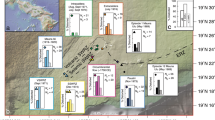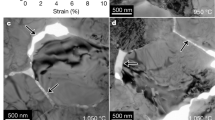Abstract
INVESTIGATION of the fabric, texture and dislocation micro-structure of olivine has given much insight into the deformation history of mantle peridotites1. Optically visible (100) subgrain boundaries (tilt or kink-band boundaries) are particularly significant in this respect. Their existence is the principal argument favouring intracrystalline glide as the mechanism of deformation2 and the spacing between them (d100) is considered to be a measure of the stress conditions during deformation3–6. Previous workers have argued that the sub-boundaries in olivine originated at the onset of deformation of periodotites1,2, predating both the recrystallised strain-free secondary grains7 and grain boundary development in general1. However, re-examination of the distribution of sub-boundaries in olivine reveals features which are quite inconsistent with this interpretation. It is suggested in the present work that (100) sub-boundaries are a late feature in these peridotites and most probably have no connection with hypothetical asthenosphere flow.
This is a preview of subscription content, access via your institution
Access options
Subscribe to this journal
Receive 51 print issues and online access
$199.00 per year
only $3.90 per issue
Buy this article
- Purchase on Springer Link
- Instant access to full article PDF
Prices may be subject to local taxes which are calculated during checkout
Similar content being viewed by others
References
Nicolas, A. & Poirier, J. P. Crystalline Plasticity and Solid State Flow in Metamorphic Rocks (Wiley, New York, 1976).
Nicolas, A., Bouchez, J. L., Boudier, F. & Mercier, J. C. Tectonophysics 12, 56–86 (1971).
Raleigh, C. B. & Kirby, S. H. Mineral. Soc. Am. Spec. Pap. 3, 113–121 (1970).
Goetze, C. Geology 3, 172–173 (1975).
Gueguen, Y. Tectonophysics 39, 231–254 (1977).
Nicolas, A. & Ricoult, D. 2nd Int. Kimberlite Conf. Abstr. (1977).
Mercier, J. C. & Nicolas, A. J. Petrol. 16, 454–487 (1975).
Raleigh, C. B. J. geophys. Res. 73, 5391–5406 (1968).
Nicolas, A., Boudier, F. & Boullier, A. M. Am. J. Sci. 273, 853–876 (1973).
Honeycombe, R. W. K. The Plastic Deformation of Metals (Edward Arnold, London, 1968).
Dash, S. & Brown, N. Acta met. 11, 1067–1075 (1963).
O'Hara, M. J. in Ultramafic and Related Rocks (ed. Wyllie, P. J.) 346–349 (Wiley, New York, 1967).
Author information
Authors and Affiliations
Rights and permissions
About this article
Cite this article
FLEET, M. Origin of olivine subgrain boundaries in mantle peridotites. Nature 275, 48–50 (1978). https://doi.org/10.1038/275048a0
Received:
Accepted:
Issue Date:
DOI: https://doi.org/10.1038/275048a0
This article is cited by
-
Silicate glass and sulfides in ultramafic xenoliths, Newer Basalts, Victoria, Australia
Contributions to Mineralogy and Petrology (1979)
Comments
By submitting a comment you agree to abide by our Terms and Community Guidelines. If you find something abusive or that does not comply with our terms or guidelines please flag it as inappropriate.



